
Two collets are included with the motor: one 1/4" (6.4 mm) and one 1/2" (13 mm). To
change collet sizes, unscrew the collet assembly as described above. Install the desired collet by
reversing the procedure.The collet and the collet nut are connected. Do not attempt to remove
the collet from the collet nut.
NOTICE: Plunge Base Only—When tightening or changing collets, do not allow the
wrenches to contact the plunge rods. If the rods are damaged, the plunge action will be
restricted.
USING THE UNIVERSAL EDGE GUIDE (FIG 1)
The universal edge guide (DW6913) is available from your local retailer or service center at extra
cost. Follow the assembly instructions included with the guide. Insert the two bars through the
holes (M) in the router base. Adjust as needed for parallel routing.
DIRECTION OF FEED (FIG. 11)
The direction of feed is very important when routing and can make the difference between a
successful job and a ruined project. Figure 11 shows the proper direction of feed for some
typical cuts. A general rule to follow is to move the router in a counterclockwise direction on an
outside cut and a clockwise direction on an inside cut.
Shape the outside edge of a piece of stock by following these steps:
1. Shape the end grain, left to right
2. Shape the straight grain side moving left to right
3. Cut the other end grain side
4. Finish the remaining straight grain edge
WARNING: Avoid climb-cutting (cutting in direction opposite than shown in
Figure11). Climb-cutting increases the chance for loss of control resulting in possible injury.
When climb-cutting is required (backing around a corner), exercise extreme caution to maintain
control of router. Make smaller cuts and remove minimal material with each pass.
CHOOSING ROUTER SPEED (DW618 ONLY) (FIG. 12)
Refer to the Speed Selection Chart to choose a router speed. Turn the speed dial (G) to
control router speed.
WARNING: Do not operate tools rated “AC only” on a DC supply. Loss of speed control
may result, causing tool damage and possible hazard to the operator.
WARNING: If the speed control ceases to operate, or is intermittent, stop using the tool
immediately. Take it to a D
EWALT factory or authorized service facility for repair.
NOTICE: The router is equipped with electronics to monitor and maintain the speed of the tool
while cutting. In low and medium speed operation, the speed control prevents the motor speed
from decreasing. If you expect to hear a speed change and continue to load the motor, you
could damage the motor by overheating. Reduce the depth of cut and/or slow the feed rate to
prevent tool damage.
Set-up: Fixed and D-Handle Base
MOTOR QUICK RELEASE (FIG. 1)
1. Open the locking lever (D) on the base.
2. Grasp the base with one hand while depressing the quick release latches (A).
3. With the other hand, grasp the top of the motor unit and lift it from the base.
INSERTING THE MOTOR INTO THE BASE (FIG. 1–3, 7)
1. Open the locking lever (D) on the base.
2. Thread the depth adjustment ring (B) onto the motor until the ring is about halfway between
the top and bottom of the motor. Insert the motor into the base by aligning the groove on
the motor (H) with the guide pins (X) on the base. Slide the motor down until the depth
adjustment ring snaps into the quick release latches (A).
NOTE: Guide pin grooves are located on either side of the motor so that it can be positioned
in two orientations.
3. Close the locking lever when the desired depth is achieved. For in formation on setting
cutting depth, refer to Adjusting the Depth of Cut.
For D-Handle Base Only
4. Be sure that the trigger switch (N) is released and the trigger lock button (O) is in the
unlocked and off position.
5. Unlock and disconnect the detachable cordset (L) from the motor.
6. Connect the detachable cordset (L) to bottom of D-Handle and lock the cord.
7. Connect the short cord (AA) from top of D-Handle to the motor as shown. Be sure the cord
is locked.
8. Place the toggle switch in the ON position. This allows the trigger switch on the D-handle to
control the router.
ADJUSTING THE DEPTH OF CUT (FIG. 1, 3)
1. Select and install the desired bit. See the heading Bit Installation and Removal.
2. Place the router on its base on the work piece.
3. Open the locking lever (D) and turn the depth adjustment ring (B) until the bit just touches
the work piece. Turning the ring clockwise raises the cutting head while turning it
counterclockwise lowers the cutting head.
4. Move the adjustable scale clockwise so that 0 on the scale is located exactly above the
pointer (Z) on the base.
5. Turn the depth adjustment ring along with the adjustable scale to the desired depth.
Note that each mark on the adjustable scale represents a depth change of 1/64" or
.015"(0.4mm).
6. Close the locking lever (D).
Operation: Fixed and D-Handle Base
GRIPPING LOCATIONS (FIG. 1)
Fixed Handle Base: Grip both knob handles (E) while operating.
D-Handle Base: Grip D-Handle (U) and knob handle (E) while operating.
The D-Handle router base has two positions for the knob to accommodate right or left hand use.
TRIGGER LOCK (FIG. 1)
D-Handle Base Only
To lock the trigger, pull the trigger switch (N) completely, then push the trigger lock button (O).
The router will remain on after you remove your finger from the trigger. To unlock the trigger
lock button, pull the trigger and release. The lock button will pop out and the router will turn off.
Set-up: Plunge Base (Fig. 1, 8–10)
MOTOR QUICK RELEASE
1. Open the locking lever (D) on the base.
2. Grasp the top of the motor unit and lift it from the base.
INSERTING THE MOTOR INTO THE PLUNGE BASE
1. Remove the depth adjustment ring from the motor. It is not used with the plunge base.
2. Open the locking lever (D) on the base to ensure that the motor properly seats.
3. Ensure that the plunge lock lever (R) is locked.
4. Align the flat of the motor’s end cap (BB) with pillar (CC) and insert the motor into the plunge
base until it stops.
5. Close the locking lever (D).
ADJUSTING THE PLUNGE ROUTING DEPTH (FIG. 8)
1. Unlock the plunge mechanism by pushing up the plunge lock lever (R). Plunge the router
down as far as it will go, allowing the bit to just touch the workpiece.
2. Lock the plunge mechanism by pushing the plunge lock lever (R) down.
3. Loosen the depth adjustment rod (Q) by turning the wingscrew (DD) counterclockwise.
4. Slide the depth adjustment rod (Q) down so that it meets the lowest turret stop (P).
5. Slide the tab (EE) on the depth adjustment rod down so that the top of it meets zero on the
pillar scale (FF).
6. Grasping the top, knurled section of the depth adjustment rod (Q), slide it up so that the tab
(EE) aligns with the desired depth of cut on the pillar scale (FF).
7. Tighten the wingscrew (DD) to hold the depth adjustment rod in place.
8. Keeping both hands on the handles, unlock the plunge mechanism by pushing the plunge
lock lever (R) up. The plunge mechanism and the motor will move up. When the router is
plunged, the depth adjustment rod will hit the turret stop, allowing the router to reach exactly
the desired depth.
FINE ADJUSTMENT OF ROUTING DEPTH
The knurled knob (GG) at the bottom end of the depth adjustment rod can be used to make
minor adjustments.
1. To decrease the cutting depth, rotate the knob clockwise (looking down from the top of the
router).
2. To increase the cutting depth, rotate the knob counterclockwise (looking down from the top
of the router).
NOTE: One complete rotation of the knob results in a change of about 5/128" or .04" (1 mm)
in depth.
USING THE ROTATING TURRET STOP (FIG. 9)
WARNING: Do not change the turret stop while the router is running. This will place your
hands too near the cutter head.
The turret depth stop can be used to set 5 different depths. One of the turret stops is adjustable.
To use the adjustable turret stop, loosen the nut (HH), then adjust the screw (II) to the desired
height. Turning the screw counterclockwise will raise the screw which will decrease the cutting
depth. The turret stop is useful for making deep cuts in several passes.
DUST EXTRACTION (FIG. 8, 10)
To connect the router to a vacuum cleaner for dust extraction, follow these steps:
1. Remove the dust cap (T) by pulling straight up.
2. Insert the dust extraction hose adapter (JJ) into the dust extraction port (KK) as shown.
3. Insert the end of a standard vacuum cleaner tube (LL) into the hose adapter.
4. When using dust extraction, be aware of the placement of the vacuum cleaner. Be sure that
the vacuum cleaner is stable and that its hose will not interfere with the work.
Operation: Plunge Base
GRIPPING LOCATIONS (FIG. 1)
Grip both knob (E) handles while operating.
CUTTING WITH THE PLUNGE BASE (FIG. 8)
CAUTION: Turn the router on before plunging the cutter head into the workpiece.
1. Unlock the plunge lock lever (R).
2. Plunge the router down until the bit reaches the set depth.
3. Lock the plunge lock lever (R).
4. Perform the cut.
5. Unlock the plunge lock lever. This will allow the router bit to disengage the work.
6. Turn the router off.
MAINTENANCE
WARNING: To reduce the risk of injury, turn unit off and disconnect it from power
source before installing and removing accessories, before adjusting or when making
repairs. An accidental start-up can cause injury.
Cleaning
WARNING: Blow dirt and dust out of all air vents with clean, dry air at least once a week.
To minimize the risk of eye injury, always wear ANSI Z87.1 approved eye protection when
performing this.
WARNING: Never use solvents or other harsh chemicals for cleaning the non-metallic parts
of the tool. These chemicals may weaken the plastic materials used in these parts. Use a cloth
dampened only with water and mild soap. Never let any liquid get inside the tool; never immerse
any part of the tool into a liquid.
NOTE FOR PLUNGE BASE ONLY: Use only a DRY cloth to wipe the plunge rods. These rods
require no lubrication. Lubricants attract dust, reducing the performance of your tool.
Accessories
WARNING: Since accessories, other than those offered by DEWALT, have not been tested
with this product, use of such accessories with this tool could be hazardous. To reduce the risk
of injury, only D
EWALT recommended accessories should be used with this product.
Recommended accessories for use with your tool are available at extra cost from your local dealer
or authorized service center. If you need assistance in locating any accessory, please contact
D
EWALT Industrial Tool Co., 701 East Joppa Road, Towson, MD 21286, call 1-800-4-DEWALT
(1-800-433-9258) or visit our website: www.dewalt.com.
Repairs
To assure product SAFETY and RELIABILITY, repairs, maintenance and adjustment (including
brush inspection and replacement) should be performed by a D
EWALT factory service center,
a D
EWALT authorized service center or other qualified service personnel. Always use identical
replacement parts.
Register Online
Thank you for your purchase. Register your product now for:
• WARRANTY SERVICE: Registering your product will help you obtain more efficient
warranty service in case there is a problem with your product.
• CONFIRMATION OF OWNERSHIP: In case of an insurance loss, such as fire, flood or
theft, your registration of ownership will serve as your proof of purchase.
• FOR YOUR SAFETY: Registering your product will allow us to contact you in the unlikely
event a safety notification is required under the Federal Consumer Safety Act.
Register online at www.dewalt.com/register.
Three Year Limited Warranty
DEWALT will repair, without charge, any defects due to faulty materials or workmanship for
three years from the date of purchase. This warranty does not cover part failure due to normal
wear or tool abuse. For further detail of warranty coverage and warranty repair information, visit
www.dewalt.com or call 1-800-4-D
EWALT (1-800-433-9258). This warranty does not apply to
accessories or damage caused where repairs have been made or attempted by others. This
warranty gives you specific legal rights and you may have other rights which vary in certain
states or provinces.
In addition to the warranty, D
EWALT tools are covered by our:
1 YEAR FREE SERVICE
D
EWALT will maintain the tool and replace worn parts caused by normal use, for free, any time
during the first year after purchase.
90 DAY MONEY BACK GUARANTEE
If you are not completely satisfied with the performance of your D
EWALT Power Tool, Laser, or
Nailer for any reason, you can return it within 90 days from the date of purchase with a receipt
for a full refund – no questions asked.
LATIN AMERICA: This warranty does not apply to products sold in Latin America. For products
sold in Latin America, see country specific warranty information contained in the packaging, call
the local company or see website for warranty information.
FREE WARNING LABEL REPLACEMENT: If your warning labels (Fig. 13) become illegible or
are missing, call 1-800-4-D
EWALT (1-800-433-9258) for a free replacement.
Défi nitions: lignes directrices en
matière de sécurité
Les définitions ci-dessous décrivent le niveau de danger pour chaque
mot-indicateur employé. Lire le mode d’emploi et porter une attention particulière
à ces symboles.
DANGER : indique une situation dangereuse imminente qui, si elle n’est pas
évitée, entraînera la mort ou des blessures graves.
AVERTISSEMENT: indique une situation potentiellement dangereuse qui,
si elle n’est pas évitée, pourrait entraîner la mort ou des blessures graves.
ATTENTION : indique une situation potentiellement dangereuse qui, si elle
n’est pas évitée, pourrait entraîner des blessures légères ou modérées.
AVIS : indique une pratique ne posant aucun risque de dommages corporels
mais qui par contre, si rien n’est fait pour l’éviter, pourrait poser des risques de
dommages matériels.
POUR TOUTE QUESTION OU REMARQUE AU SUJET DE CET OUTIL OU DE TOUT
AUTRE OUTIL D
EWALT, COMPOSEZ LE NUMÉRO SANS FRAIS : 1-800-4-DEWALT
(1-800-433-9258).
AVERTISSEMENT : afin de réduire le risque de blessures, lire le mode d’emploi de l’outil.
Avertissements de sécurité généraux pour les outils
électriques
AVERTISSEMENT ! Lire tous les avertissements de sécurité et toutes les
directives. Le non-respect des avertissements et des directives pourrait se solder par
un choc électrique, un incendie et/ou une blessure grave.
CONSERVER TOUS LES AVERTISSEMENTS ET TOUTES LES
DIRECTIVES POUR UN USAGE ULTÉRIEUR
Le terme « outil électrique » cité dans les avertissements se rapporte à votre outil électrique à
alimentation sur secteur (avec fil) ou par piles (sans fil).
1) SÉCURITÉ DU LIEU DE TRAVAIL
a) Tenir l’aire de travail propre et bien éclairée. Les lieux encombrés ou sombres sont
propices aux accidents.
b) Ne pas faire fonctionner d’outils électriques dans un milieu déflagrant, tel qu’en
présence de liquides, de gaz ou de poussières inflammables. Les outils électriques
produisent des étincelles qui pourraient enflammer la poussière ou les vapeurs.
c) Éloigner les enfants et les personnes à proximité pendant l’utilisation d’un outil
électrique. Une distraction pourrait en faire perdre la maîtrise à l’utilisateur.
2) SÉCURITÉ EN MATIÈRE D’ÉLECTRICITÉ
a) Les fiches des outils électriques doivent correspondre à la prise. Ne jamais
modifier la fiche d’aucune façon. Ne jamais utiliser de fiche d’adaptation avec un
outil électrique mis à la terre. Le risque de choc électrique sera réduit par l’utilisation
de fiches non modifiées correspondant à la prise.
b) Éviter tout contact physique avec des surfaces mises à la terre comme des
tuyaux, des radiateurs, des cuisinières et des réfrigérateurs. Le risque de choc
électrique est plus élevé si votre corps est mis à la terre.
c) Ne pas exposer les outils électriques à la pluie ou à l’humidité. La pénétration de
l’eau dans un outil électrique augmente le risque de choc électrique.
d) Ne pas utiliser le cordon de façon abusive. Ne jamais utiliser le cordon pour
transporter, tirer ou débrancher un outil électrique. Tenir le cordon éloigné de
la chaleur, de l’huile, des bords tranchants et des pièces mobiles. Les cordons
endommagés ou enchevêtrés augmentent les risques de choc électrique.
e) Pour l’utilisation d’un outil électrique à l’extérieur, se servir d’une rallonge
convenant à cette application. L’utilisation d’une rallonge conçue pour l’extérieur
réduira les risques de choc électrique.
f) S’il est impossible d’éviter l’utilisation d’un outil électrique dans un endroit
humide, brancher l’outil dans une prise ou sur un circuit d’alimentation dotés
d’un disjoncteur de fuite à la terre (GFCI). L’utilisation de ce type de disjoncteur réduit
les risques de choc électrique.
3) SÉCURITÉ PERSONNELLE
a) Être vigilant, surveiller le travail effectué et faire preuve de jugement lorsqu’un
outil électrique est utilisé. Ne pas utiliser d’outil électrique en cas de fatigue
ou sous l’influence de drogues, d’alcool ou de médicaments. Un simple moment
d’inattention en utilisant un outil électrique peut entraîner des blessures corporelles
graves.
b) Utiliser des équipements de protection individuelle. Toujours porter une
protection oculaire. L’utilisation d’équipements de protection comme un masque
antipoussière, des chaussures antidérapantes, un casque de sécurité ou des protecteurs
auditifs lorsque la situation le requiert réduira les risques de blessures corporelles.
c) Empêcher les démarrages intempestifs. S’assurer que l’interrupteur se trouve
à la position d’arrêt avant de relier l’outil à une source d’alimentation et/ou
d’insérer un bloc-piles, de ramasser ou de transporter l’outil. Transporter un outil
électrique alors que le doigt repose sur l’interrupteur ou brancher un outil électrique dont
l’interrupteur est à la position de marche risque de provoquer un accident.
d) Retirer toute clé de réglage ou clé avant de démarrer l’outil. Une clé ou une clé de
réglage attachée à une partie pivotante de l’outil électrique peut provoquer des blessures
corporelles.
e) Ne pas trop tendre les bras. Conserver son équilibre en tout temps. Cela permet
de mieux maîtriser l’outil électrique dans les situations imprévues.
f) S’habiller de manière appropriée. Ne pas porter de vêtements amples ni de
bijoux. Garder les cheveux, les vêtements et les gants à l’écart des pièces
mobiles. Les vêtements amples, les bijoux ou les cheveux longs risquent de rester
coincés dans les pièces mobiles.
g) Si des composants sont fournis pour le raccordement de dispositifs de
dépoussiérage et de ramassage, s’assurer que ceux-ci sont bien raccordés et
utilisés. L’utilisation d’un dispositif de dépoussiérage peut réduire les dangers engendrés
par les poussières.
4) UTILISATION ET ENTRETIEN D’UN OUTIL ÉLECTRIQUE
a) Ne pas forcer un outil électrique. Utiliser l’outil électrique approprié à l’application.
L’outil électrique approprié effectuera un meilleur travail, de façon plus sûre et à la vitesse
pour laquelle il a été conçu.
b) Ne pas utiliser un outil électrique dont l’interrupteur est défectueux. Tout outil
électrique dont l’interrupteur est défectueux est dangereux et doit être réparé.
c) Débrancher la fiche de la source d’alimentation et/ou du bloc-piles de l’outil
électrique avant de faire tout réglage ou changement d’accessoire ou avant de
ranger l’outil. Ces mesures préventives réduisent les risques de démarrage accidentel
de l’outil électrique.
d) Ranger les outils électriques hors de la portée des enfants et ne permettre à
aucune personne n’étant pas familière avec un outil électrique ou son mode
d’emploi d’utiliser cet outil. Les outils électriques deviennent dangereux entre les
mains d’utilisateurs inexpérimentés.
e) Entretien des outils électriques. Vérifier si les pièces mobiles sont mal alignées
ou coincées, si des pièces sont brisées ou présentent toute autre condition
susceptible de nuire au bon fonctionnement de l’outil électrique. En cas de
dommage, faire réparer l’outil électrique avant toute nouvelle utilisation.
Beaucoup d’accidents sont causés par des outils électriques mal entretenus.
f) S’assurer que les outils de coupe sont aiguisés et propres. Les outils de coupe bien
entretenus et affûtés sont moins susceptibles de se coincer et sont plus faciles à maîtriser.
g) Utiliser l’outil électrique, les accessoires, les forets, etc. conformément aux
présentes directives en tenant compte des conditions de travail et du travail
à effectuer. L’utilisation d’un outil électrique pour toute opération autre que celle pour
laquelle il a été conçu est dangereuse.
5) RÉPARATION
a) Faire réparer l’outil électrique par un réparateur professionnel en n’utilisant
que des pièces de rechange identiques. Cela permettra de maintenir une utilisation
sécuritaire de l’outil électrique.
Règles de sécurité spécifi que concernant les toupies
• Tenir l’outil électrique par ses parties isolées, car l’organe de coupe pourrait
entrer en contact avec son cordon. Couper un fil sous tension pourra mettre les parties
métalliques exposées de l’outil électrique sous tension et électrocuter l’utilisateur.

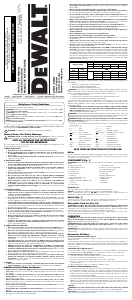


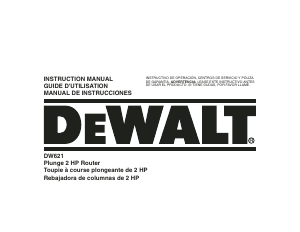


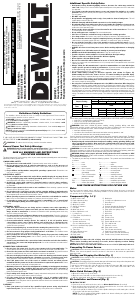
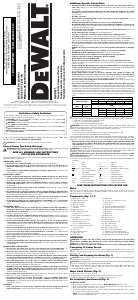
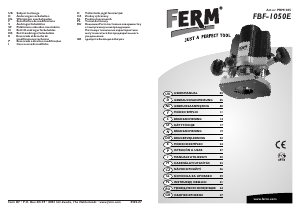
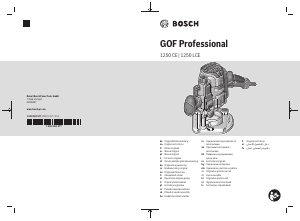
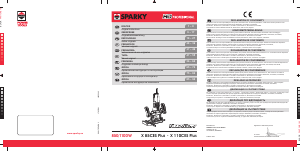
Únase a la conversación sobre este producto
Aquí puedes compartir lo que piensas sobre DeWalt DW616 Fresadora de superficie. Si tiene alguna pregunta, primero lea atentamente el manual. Puede solicitar un manual utilizando nuestro formulario de contacto.